This is a battle report that a friend of mine wrote for a game I played against him recently. The rules were Warlord Games's Black Powder. The scenario was one I invented, which I have posted here. If you try out the scenario, please leave a comment and let me know how it went, and what changes you made or would suggest. The basic idea is that one side is escorting some supplies down a road, and the other side is setting up an ambush to steal or destroy the supply wagons. Here's how our game played out.
Deployment
Confederate Cavalry deploys one regiment (8th Tennessee) in skirmish across the road, and a second regiment (4th Tennessee) to the right flank, also in skirmish. Brigadier General Forrest deploys between the two regiments, keeping, for the moment, to the woods immediately to the east of the road.
Union infantry, led by Brigadier General Meagher, deploy to the west of the road to secure the Union right flank. One regiment (69th New York) deploys in skirmish to move through the woods. Immediately to the north of this are three more infantry regiments in march column (88th New York, 116th Pennsylvania, and the 28th Massachusetts) facing the road. This may prove to be a nasty hammer-blow to the supply train. On the eastern edge of the battlefield a fifth regiment of infantry (63rd New York), deployed in line, supports a battery of foot artillery and is overseen by Major General Winfield Scott Hancock.
Confederate Turn One
The 4th Tennessee is ordered by Brigadier Forrest to move forward at all possible haste in order to reconnoiter the disposition of possible Union deployment upon the large hill conveniently overlooking the road. The 8th Tennessee is ordered forward at a moderate pace in order to maintain a cavalry screen for the infantry brigade following. Brigadier Forrest maintains his position directly between the two regiments.
General Longstreet orders the infantry brigade (currently including the supply column) forward at all possible speed. The good General sees the road ahead is ripe for an ambush and wishes to cover as much ground as possible. His Brigade commanders, while in agreement, move ahead cautiously.
Union Turn One
Major General Hancock, on the Union Left, orders the lumbered artillery to take position atop the hill and deploy. The poor Union soldiers, manhandling the guns, barely make the top of the hill before collapsing from the effort.
The infantry brigade opts to remain in wait for the unsuspecting secessionists.
Confederate Turn Two
Brigadier Forrest orders the 4th Tennessee forward to the hill, and the 8th Tennessee forward a steady pace and to form up. The 8th Tennessee detects the glint of metal in the woods to their left and sounds off that the enemy is sighted.
General Longstreet orders the infantry brigade to move forward directly behind the 8th Tennessee and to the left of the road, wishing to avoid holding up the supply column. The infantry, excited at the prospect of engaging the enemy, does so with speed. General Longstreet then orders the supply column to keep abreast of the infantry brigade and entrusts Brigadier Forrest to secure the right.
Union Turn Two
Having been spotted, Major General Hancock calls for reinforcements and is answered by the distant bugles of the 1st and 5th Michigan Wolverines, a cavalry brigade, commanded Brigadier General George Armstrong Custer.
On the Union right Brigadier Meagher order the 88th New York, 116th Pennsylvania, and the 28th Massachusetts to move forward and bar the road, forming into line once there. Confused by the sudden prevalence of bugle calls, the three regiments are slow moving forward and do not even gain the road. Red-faced with anger, Meagher orders the 69th New York to wheel left in order to ravage the rebel flanks but whether due Meagher’s anger or the aforementioned bugle cacophony, the 69th New York instead panics and flies into full retreat.
On the Union left Major General Hancock orders the foot artillery to deploy, and then orders the 63rd New York to crest the hill and establish a support position directly to the left of the battery. Brigadier Custer leads his two regiments of cavalry cautiously from the east and attempts to take the south end of the hill in the face of the oncoming 4th Tennessee. Directly to the north of them, Custer orders the horse artillery to form up on the right of the foot artillery. Again, caution rules the day and the horse artillery advances, but slowly.
Atop the hill, the foot artillery opens fire upon the leading elements of the Confederates on the road, hitting the 8th Tennessee with a barrage of round shot. The morale of the rebel horsemen holds true, and they ride through the exploding turf dramatically.
Confederate Turn Three
On the Confederate right, Brigadier Forrest orders the 4th Tennessee to form up and charge the enemy cavalry attempting to take the hill. There is, at first, some confusion but Forrest orders them again and they manage to form up. Forrest then boldly orders the 8th Tennessee to charge the Union foot artillery. They come close but end up at the bottom of the hill instead as the Union gunners ram home more round shot.
Brigadier Hood orders the infantry brigade to charge ahead and form line to either side of the road in order to engage the encroaching Union foot regiments. Alas, Hood’s low decisiveness cost some motivation and the Confederate foot merely charged forward whooping and hollering but not achieving their General’s wishes. General Longstreet ordered the supply wagons to move, post haste, in order to break past the Union foot regiments before they can get positioned.
Union Turn Three
Brigadier Meagher again orders his three foot regiments to form line and bar the road. Again, the three regiments move slowly. Meagher then orders the 69th New York to reform, and advance into the Confederate’s left. The confusion of the last few moments means that the New Yorkers manage only to reform and actually face the enemy. This is a small victory in and of itself, all things considered.
Hancock orders the foot artillery to manhandle their guns forward to canister range but due to the proximity of the howling enemy they do not move. Hancock also orders Battery M of the horse artillery to form up on the right flank of the foot battery.
Custer, on the far left of the Union lines, orders the 1st Michigan to advance to the other side of the hill and form line facing the Confederate infantry but they only manage to take the top of the hill. Custer then rides into the ranks of the 5th Michigan and orders them to follow him into line facing the 4th Tennessee and charge.. an order the 5th follows with abandon.
In the Union center both artillery batteries open up on the 8th Tennessee but perhaps due to the incline of the hill or the brazen charge of the cavalry, all rounds pass harmlessly over the heads of the cavalry. The 63rd New York, having wheeled to face the same regiment of Confederate cavalry, opens fire but the furious tirade spatters harmlessly off the ground and rocks.
On the left, the 4th Tennessee countercharges the 5th Michigan and meets them in mortal combat at the foot of the hill. Such is the fervor of the 4th Tennessee that the combat results in a draw! Both regiments fall back a piece in order to regroup.
Confederate Turn Four
Brigadier Hood orders the Confederate infantry brigade to form line and charge the flanks of the Union infantry but with so many regiments in close proximity they manage only to reform.
On the Confederate far left, the 8th Tennessee charges the artillery batteries, hoping to cripple them. Focusing their efforts on the horse artillery at the left, the Tennessee cavalry is subjected to a withering cannonade.
Forrest himself gallops into the ranks of the 4th Tennessee and with a rebel yell they charge into the flank of the 1st Michigan.
At the left, the 8th Georgia and 4th Texas, inflicting moderate casualties and sending the 88th New York into disorder.
The 8th Tennessee ravages the horse artillery, destroying them utterly. Holding their momentum, the 8th Tennessee circles round the rear to threaten the remaining artillery battery and Major General Hancock himself.
The 4th Tennessee, led by Forrest and not to be outdone, breaks the 1st Michigan and forces them back. The 4th then carries their momentum and charges the 5th Michigan. Custer leads his men into a brave combat and the Wolverines completely destroy the impetuous 4th. Forrest’s disposition is not known but he is feared to be gravely wounded.
Union Turn Four
At the Union right, Meagher gets the infantry moving and the line is finally formed to block the road. The 69th New York manages to close up with the rest of the infantry brigade but little else.
At the Union left, Hancock attempts to rally the 5th Michigan but the deviled kidneys he’d had for breakfast intervened and the rally failed as Hancock instead retched onto the hilltop. Custer, however, was able to rally the 1st Michigan, preparing for a renewed assault on the plump target presented by Confederate infantry in march column.
The foot artillery, having spun their pieces round to face the 8th menacing their rear, opens fire. The torrent of canister inflicts casualties but the Tennessee cavalry bravely weathers the rain of scrap metal. The 63rd New York, also having wheeled to face the cavalry, opens fire and this brutal fusillade proves to be enough to break the brave cavalrymen and the 8th Tennessee follows the 4th in scattering and fleeing.
At the Union center, the 88th New York and 118th Pennsylvania direct their fire at the 18th Georgia but casualties were low.
Confederate Turn Five
At the center, Brigadier Hood orders the 4th Texas to charge the 88th New York. The 18th Georgia, being disordered, opts to fire. The 1st Texas wheels right to face the Union Cavalry threatening their position as the far Confederate left, owing to the dispersal of the Confederate cavalry.
The Texans and the Georgians concentrate their fire on the 118th Pennsylvania but the tirade is not enough to inflict significant damage. At the Confederate right the 1st Texas fires at Custer’s Cavalry and sends them into disorder and avoiding a dangerous charge from the horsemen for the moment.
The combat at the Confederate left results in the 88th New York falling back and flying into disorder. A small victory to be sure.
Union Turn Five
The 118th Pennsylvania wheels to the right to face the Confederate lines, and Meagher orders the 69th to wheel and face the enemy lines but confusion in the ranks fails to carry the order to completion. The foot artillery again wheels their guns around to face the enemy, and the 63rd New York again performs a well ordered about-face to face the enemy. The rattle of ramrods tells of the coming hail of lead as much as the unit’s positions do.
The 69th New York opens fire on the 5th Texas, inflicting no casualties but causing disorder in the ranks. The 4th Texas then faces the combined fire of both the 118th and 88th New York. The artillery battery sends a handful of shot over the heads of the Union lines and into the 18th Georgia, sending them into disorder and wreaking havoc among the ranks.
Confederate Turn Six
General Longstreet, keeping his objective in mind, orders the supply train to break for the woods and circle around the Union right and commands Hood to distract the Union infantry in order to give the supply wagons a chance to break through. Hood debates with his aides-de-camps about whether or not to move the 3rd Arkansas forward and the indecisiveness costs them any meaningful progress. The rest of the infantry, being somewhat disordered, reloads and prepares to fire at the Union lines.
The 5th Texas fires at the retreating 88th New York, but they hold their ground. The rest of the Confederate shooting is as ineffectual with the exception of the 1st Texas whose fusillade breaks the already weakened 5th Michigan, Custer fleeing with them.
Union Turn Six
The 88th New York reforms using their own initiative, and turns about to face the Confederate lines, furiously reloading whilst they maneuver. The 63rd New York moves forward to position onto the far Union left. General Hancock attempts to rally the Michigan cavalry, telling them that the loss of their Brigadier shouldn’t be cause for them to mill about. Alas, the realization that Custer had been sent packing was too much for them and they instead “repositioned toward the Union rear.”
The 5th Texas weather the fire of both the 88th and the 69th. The 28th Pennsylvania fires at the 4th Texas, inflicting casualties but little else. The artillery again brutalizes the 18th Georgia.
Confederate Turn Seven
The Confederate Supply regiment continues its attempt to pass round the Union left. The Confederate infantry brigade continues its fusillade and the two points of note are the 28th Massachusetts finally breaking and the 118th Pennsylvania shrugging off what could have been a crippling tirade.
Union Turn Seven
The 88th New York, ordered to rally by Meagher, blundered when they saw the Confederate “column” erupting from the trees right behind Meagher and rather than rally they broke. On the far Union left, the 69th close to short range and level their muskets at the 1st Texas.
The Union firing caused little effect, save the near breaking of the 5th Texas and the decimation and routing of the 18th Georgia.
Confederate Turn Eight
Hood orders the 4th Texas to charge, but thinks better of it… then decides it should be a good idea. Or is it? The moment passes and the 4th Texas fails to charge. The supply train continues its attempted breakout.
Another volley from the Confederate lines ravages the 116th Pennsylvania, but apparently little else is accomplished beyond raw attrition.
Union Turn Eight
The attrition from the recent Confederate volley causes a ripple in the Union lines, which quickly turns into the entire line retiring, having been broken by the withering fire from the grey-clad rebels.
The retreating troops fire a volley to cover their withdrawl, but to practically no effect. The rebel stamina holds true, and the supply train escapes the field to bring much needed supplies to a nearby battle.



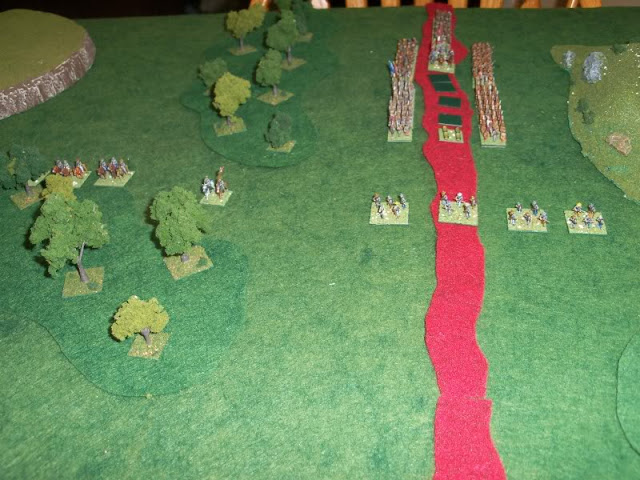









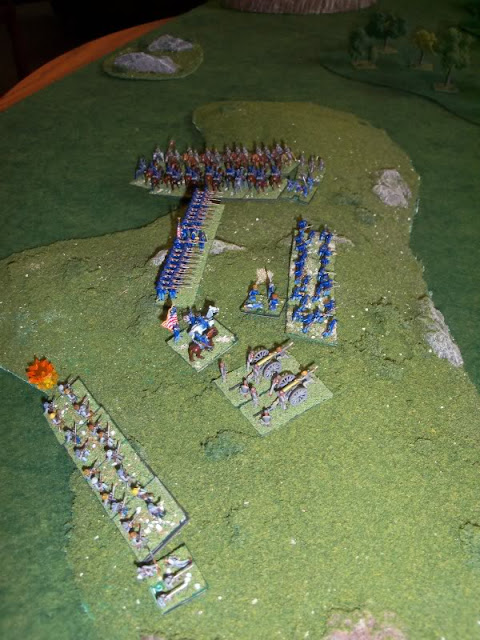
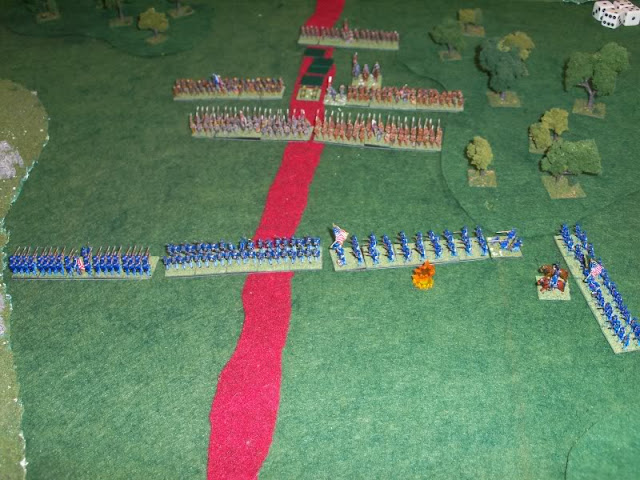
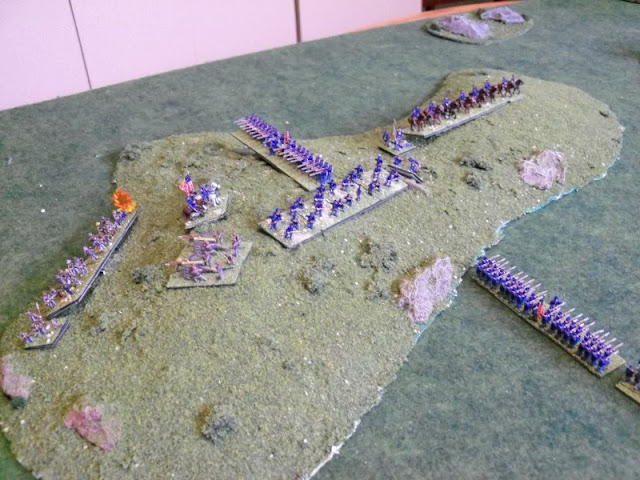









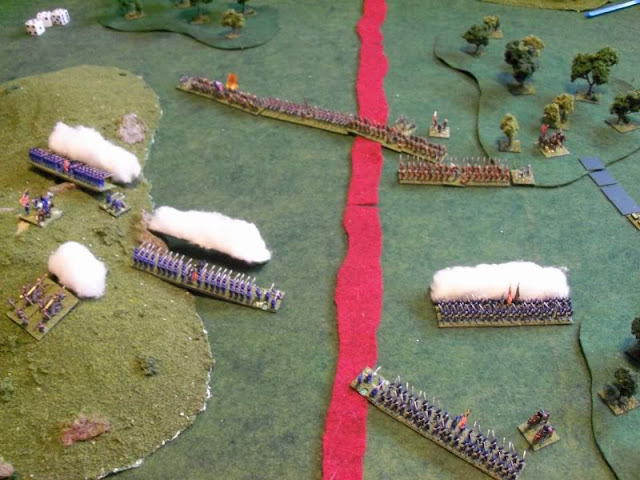
Hey, cool battle report, hope to see more. What kind of minis do you use? Like what brand and size? Thanks!
ReplyDeleteThey are GHQ 10mm. You can check out their website here: GHQ Miniatures.
ReplyDelete